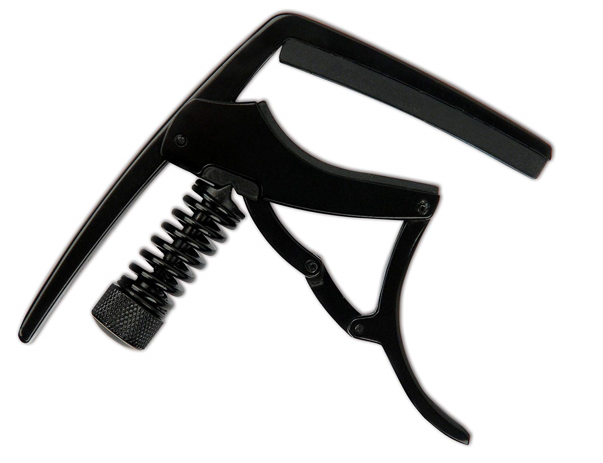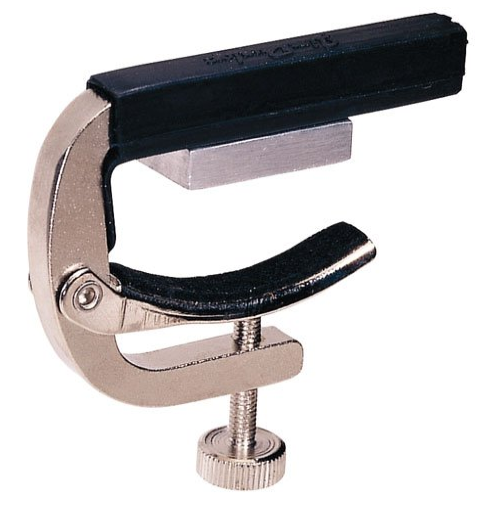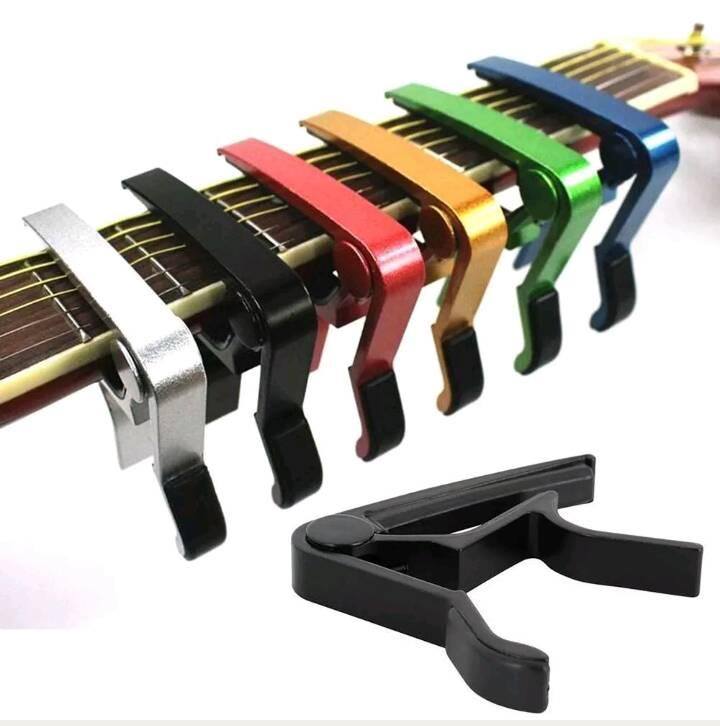Capos are devices that clamp across the fingerboard at a specific fret on a guitar. They can function differently, beginning from elastic, springs, to threaded bolts. However, they all serve the similar purpose of shortening the length of all the guitar strings simultaneously. Currently, the open strings play in higher pitches than they do minus the Capo.
It is not mandatory to use it on an electric guitar, but there are so many benefits to it. A capo generates a moveable nut. For instance, placing the Capo on the second fret moves all the chords up one step. Additionally, they also make it possible to play familiar chord shapes in a different key.
This means that they play a half step for each fret. For example, if you place the Capo at the 3rd fret, the open E strings become G’s. The list continues as B turns into D, A into C, and D becomes F. you place the Capo just before the fret and not directly over the metal fret wire.
So with a capo, you can play some previously hard to reach tunes utilizing transposing savvy, and a handful of chords. Furthermore, you can explore different chord voicings, or inversions, with a capo. This makes a chord sound brighter or darker and picking interesting. To add on, it is appropriate when changing tunes to a more comfortable range, or key, for vocals.
Are All Guitar Capos The Same?
As it is the nature of many things, there are a different number of capo types with different attributes and features to choose from. Depending on the situation, different capos will meet your needs differently. So it is right to say that there are different types of capos. There are three major types which we shall discuss.
Spring Loaded Guitar Capo

This is a suitable one for speed. It is not complicated to put on and remove it from the guitar. This should be the reason why many people like them. Moreover, these capos allow you to just one hand since you operate it just like any other basic clamp. Their simple design is one of their most attractive benefits as they are reliable because they don’t have many moving parts to be of concern.
Besides, they are also cheap to produce. Contrariwise, the capos have flaws as you can’t manually adjust the amount of pressure they apply to the strings. The deficiency can lead to the bending of the strings in the case of stress. In the case where one has severe use, we do not recommend Spring-loaded capos. They are more applicable when you have lone practice sessions. Spring-loaded capos are not very reliable in live sessions.
C-Clamp Capos

These capos are more reliable in more serious use. It is because they offer far more reliable and more consistent performance than a spring-loaded one. The C Capos can adjust the pressure exerted on the strings every time.
Obviously, you have an essential level of control in a live performance with C-Clamp capos. Generally, this type of capos is very rugged.
On the contrary, there are not many problems with this Capo. The main issue you will have with C-Clamp capos is that they require more effort to clamp and remove from a guitar. Moreover, this type of Capo requires more than just one hand. In other words, you will need some more time to install everything correctly and adjust the pressure. Also, they are more costly than the spring-loaded ones by 20-50%.
Toggle Capo

Toggle capos are the very best solution. They are very light, compact capos that often use a polyester band instead of a clamp. Furthermore, they are straightforward to use and are cheap, making them affordable enough for anyone. In a Toggle type, the extent of pressure distribution is inconsistent and decent at best.
Their tendency to come loose is their main disadvantage. Then again, the Capo can bend strings as well. They are suitable for practice and home use due to their inconsistencies. Therefore, they are not appropriate for earnest performances. Consequently, it means that the C capos are the ones that are the best when it comes to live performances. This is because they are more reliable and consistent. It follows, therefore, that there are different types of capos you can choose from depending on your needs. Need to say, the above significant classes of capos can be subdivided into more other kinds.
Can You Use An Acoustic Capo On An Electric Guitar?
Generally, it is possible to Capo all types of guitars, including ukulele, a band. Just that it is not common to clamp them on electric guitar, you can use them in live settings.
During studio/recording sessions, people commonly use capos on both electric and acoustic guitars. They mostly take advantage of layered rhythm parts and fills and make them match one another.
Those who exclusively play riffs and solo guitar and fewer chords rhythm, do not often use a capo. In a live setting, it is even more severe if they have to take a capo on and off a guitar. When you clamp it with so much tension on an electric guitar, they slightly get out of tune. This is because they tend to have lighter string gauges.
Can A Capo Damage My Guitar?
Most commonly, capos operate using a high-tension spring. This might pose a danger when the Capo you leave the Capo on the guitar. On the contrary, it is less likely to wear the pads on the Capo because of the pressure more than the friction.
When not in use, you should remove the Capo from the guitar. In case you don’t remove the Capo, you may wear out the strings. To explain this, when you leave it on the neck, it holds the strings down on the fretboard. When left for a more extended period, it creates extra tension on the top of the guitar. In their design, all guitars have been built in a way that they will have problems in case of the pressure of the strings.
Do Professional Guitarists Use Capos?
Over ten years ago, capos came back into fashion. Accurate to state, in the 1980s to the 2000s, professionals did not use them widely. This was mostly because of how they were designed in those days always put the guitar out of tune. Logically, learning to play different chords was proper than to spend five minutes tuning on stage.
Two changes have made a big difference in guitar technology over the past ten years. First of all, spring-type capos have become more comfortable to use than the old Stirrup Capos. When handled with care, they don’t necessarily affect the tuning, while screw-type capos can be adjusted well without changing the tuning. Again, headstock tuners for acoustic guitars have made it possible to tune the guitar easily and quickly. Also, the presence of capos with built-in tuners has made it convenient for professional guitarists to use them.
Can You Use A Guitar Capo On Ukulele?
Though guitar and ukulele capos are the same in appearance, they differ in size and tension. You can use a guitar capo on ukulele. However, it is better to use a ukulele capo because guitar capo can cause damage to the strings on your ukulele by increasing tension.
If a guitar capo is adjustable, it does not pause danger on a ukulele. Also, a guitar capo with a correct shape is better, because it will exert less pressure. Using the wrong shape causes tuning problems. As long as you don’t get a guitar capo too tight on a ukulele, you can use it.
Conclusion
Modern-day capos have made it enjoyable to use guitars in music. You can use capos on electric guitars, although it is not mandatory. However, capos increase your experience with them. Furthermore, all guitar capo types are not the same, and with differing needs, you could choose from the variety that exists.
Moreover, it is possible to Capo all types of guitars. If you leave capos on guitars, they can cause significant damage because of the tension they create. Due to advancements in technology, professional guitarists find it possible to use them. In conclusion, you can use guitar capos can on ukuleles.

